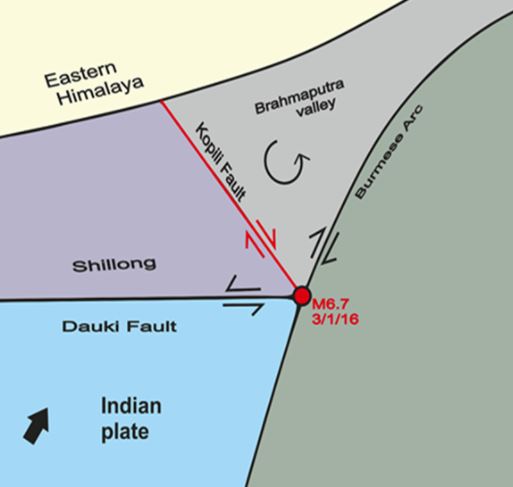ForumIAS announcing GS Foundation Program for UPSC CSE 2025-26 from 19 April. Click Here for more information.
ForumIAS Answer Writing Focus Group (AWFG) for Mains 2024 commencing from 24th June 2024. The Entrance Test for the program will be held on 28th April 2024 at 9 AM. To know more about the program visit: https://forumias.com/blog/awfg2024
What is the News?
The National Centre for Seismology (NCS) has said that the tremors in Assam can be attributed to the Kopili Fault Zone. The fault zone is located closer to Himalayan Frontal Thrust (HFT).
About the tremors in Assam:
Recently an earthquake of magnitude 6.4 on the Richter scale hit Assam. Following the main tremors, six aftershocks (of magnitude ranging from 3.2 to 4.7) also occurred within two-and-a-half hours. The NCS recently mentioned that these tremors were attributed to the Kopili Fault Zone.
Kopili Fault Zone:
- The Kopili fault zone is a 300-km northwest-southeast trending fault. It is extending from the western part of Manipur to the tri-junction of Bhutan, Arunachal Pradesh and Assam.
- A fault is a fracture or zone of fractures between two blocks of rock. Faults allow the blocks to move relative to each other. This movement may occur rapidly, in the form of an earthquake. Or it may occur slowly, in the form of creep.
- Seismically Active: This zone is a seismically active area, so it falls into the highest Seismic Hazard Zone V.
- The zone is associated with collisional tectonics because of the Indian Plate subducting beneath the Eurasian Plate.
- Subduction is a geological process in which one crustal plate is forced below the edge of another.
- Characteristics: Kopili fault zone and its neighbouring areas are characterised by alluvial soils. These alluvial soil have a higher potential of trapping seismic waves. Thus making the region the most earthquake-prone zone in North East India.
- Earlier Earthquakes: Kopili fault zone has witnessed many seismic activities in the past. This includes the 1869 earthquake (7.8 magnitude) and the 1943 earthquake (7.3 magnitude).
About Himalayan Frontal Thrust (HFT):
It is also known as the Main Frontal Thrust (MFT). It is a geological fault along the boundary of the Indian and Eurasian tectonic plates.
Way Forward:
- Firstly, the government has to fix the knowledge and policy gap regarding earthquakes in North East India.
- Secondly, the government has to build an effective Earthquake mitigation plan.
- Thirdly, an integrated disaster management plan should be developed for the North East. This plan will help in tackling these types of high-intensity earthquakes.
Source: Down To Earth





